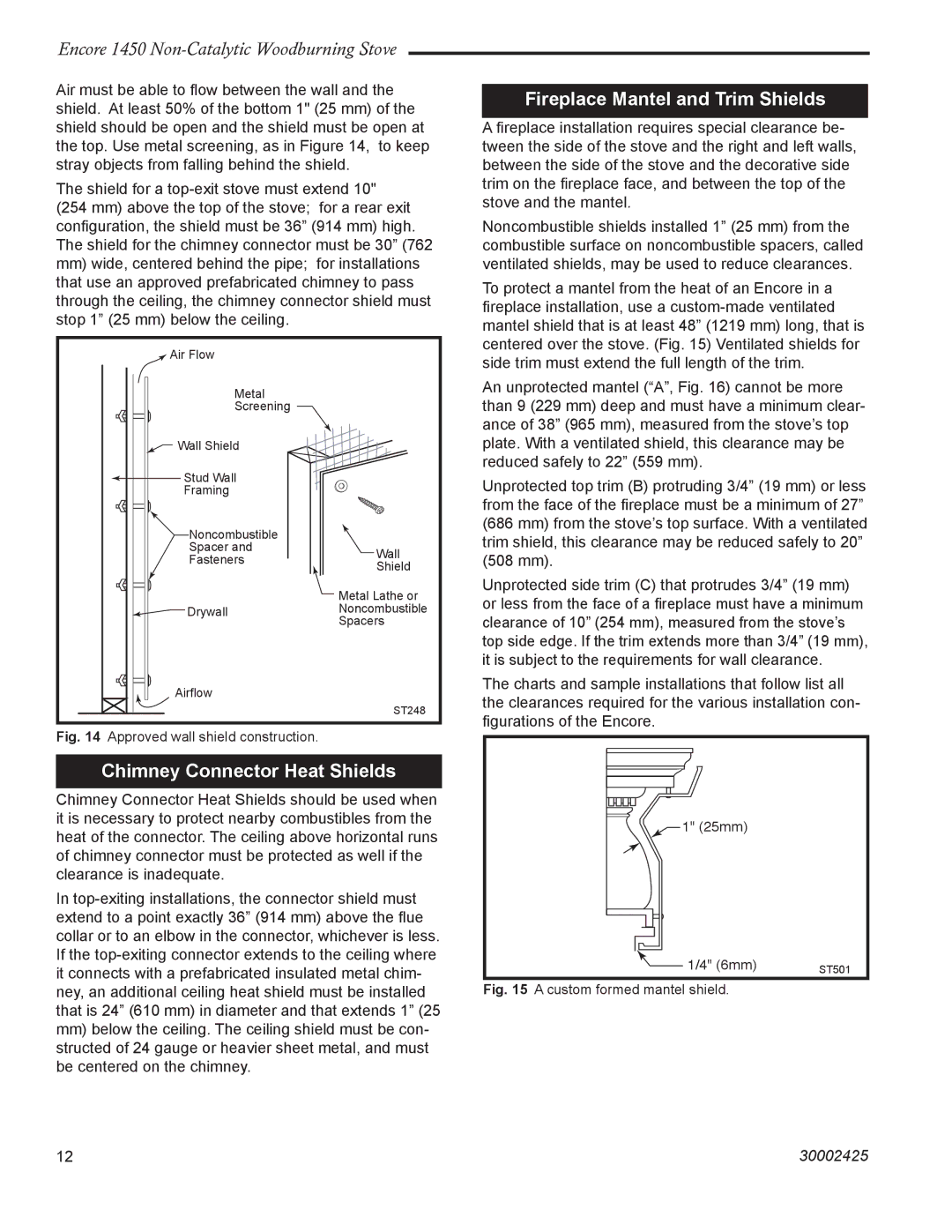
Encore 1450
Air must be able to flow between the wall and the shield. At least 50% of the bottom 1" (25 mm) of the shield should be open and the shield must be open at the top. Use metal screening, as in Figure 14, to keep stray objects from falling behind the shield.
The shield for a
(254 mm) above the top of the stove; for a rear exit configuration, the shield must be 36” (914 mm) high. The shield for the chimney connector must be 30” (762
mm)wide, centered behind the pipe; for installations that use an approved prefabricated chimney to pass through the ceiling, the chimney connector shield must stop 1” (25 mm) below the ceiling.
Air Flow |
| |
Metal |
| |
Screening |
| |
Wall Shield |
| |
Stud Wall |
| |
Framing |
| |
Noncombustible |
| |
Spacer and | Wall | |
Fasteners | ||
Shield | ||
| ||
| Metal Lathe or | |
Drywall | Noncombustible | |
Spacers | ||
| ||
Airflow |
| |
| ST248 |
Fig. 14 Approved wall shield construction.
Chimney Connector Heat Shields
Chimney Connector Heat Shields should be used when it is necessary to protect nearby combustibles from the heat of the connector. The ceiling above horizontal runs of chimney connector must be protected as well if the clearance is inadequate.
In
mm)below the ceiling. The ceiling shield must be con- structed of 24 gauge or heavier sheet metal, and must be centered on the chimney.
Fireplace Mantel and Trim Shields
A fireplace installation requires special clearance be- tween the side of the stove and the right and left walls, between the side of the stove and the decorative side trim on the fireplace face, and between the top of the stove and the mantel.
Noncombustible shields installed 1” (25 mm) from the combustible surface on noncombustible spacers, called ventilated shields, may be used to reduce clearances.
To protect a mantel from the heat of an Encore in a fireplace installation, use a
An unprotected mantel (“A”, Fig. 16) cannot be more than 9 (229 mm) deep and must have a minimum clear- ance of 38” (965 mm), measured from the stove’s top plate. With a ventilated shield, this clearance may be reduced safely to 22” (559 mm).
Unprotected top trim (B) protruding 3/4” (19 mm) or less from the face of the fireplace must be a minimum of 27” (686 mm) from the stove’s top surface. With a ventilated trim shield, this clearance may be reduced safely to 20” (508 mm).
Unprotected side trim (C) that protrudes 3/4” (19 mm) or less from the face of a fireplace must have a minimum clearance of 10” (254 mm), measured from the stove’s top side edge. If the trim extends more than 3/4” (19 mm), it is subject to the requirements for wall clearance.
The charts and sample installations that follow list all the clearances required for the various installation con- figurations of the Encore.
![]() 1" (25mm)
1" (25mm)
1/4" (6mm) | ST501 |
Fig. 15 A custom formed mantel shield.
12 | 30002425 |
